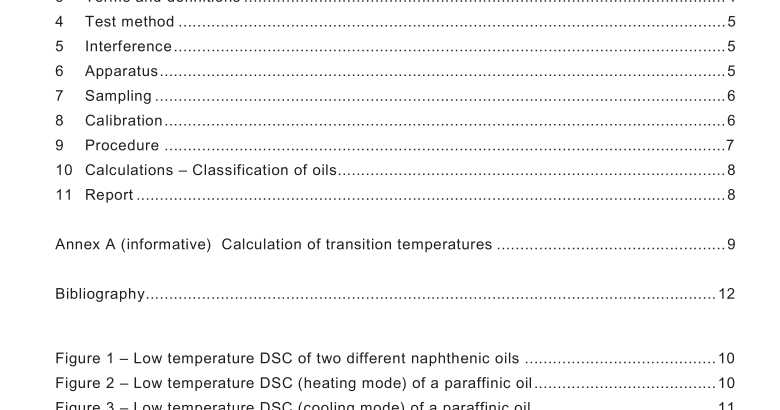IEC TR 61946:2007 pdf download – Mineral insulating oils — Characterization of paraffinic/naphthenic nature — Low temperature differential scanning calorimetry (DSC) test method
This technical report offers a test method for the classification of mineral insulating oils aseither paraffinic or naphthenic, by means of low-temperature differential scanning caiorimetry(DSC).
For the purpose of this technical report, the typical operating temperature range extends from-100 °C to +100°C. The temperature range can be extended,depending upon theinstrumentation used.
The method is applicable to mineral insulating oils obtained from petroleum crudes. lt may bealso applied to mineral oils containing pour point depressants,as these additives do notprevent the formation of paraffin crystals but only the growing of such micro-crystals.
2Normative references
The following referenced documents are indispensable for the application of this document.For dated references,only the edition cited applies.For undated references, the latest editionof the referenced document (including any amendments) applies.
IEC 60475,Method of sampling liquid dielectrics
3Terms and definitions
For the purposes of this document, the following terms and definitions apply.
3.1
paraffinic oil
mineral insulating oil containing crystallizable paraffins
3.2
naphthenic oil
mineral insulating oil which does not contain crystallizable paraffins
NOTE Naphthenic oils usually contain paraffins as well, but they are branched paraffins which do not formcrystals at very low temperatures.
3.3
differential scanning calorimetryDsc
technique in which the difference in energy inputs into a test material and a reference materialis measured as a function of temperature while the test and the reference materials aresubjected to a controlled temperature programme
NOTE In this report the terms “heat”, “heat of fusion” and “heat of crystallization” used throughout the test aretaken to be equivalent to the phrases “enthalpy”, “enthalpy of fusion” and “enthalpy of crystallization”, respectively,
4 Test method
The method consists of heating (or cooling) the test specimen at a controlled rate in a controlled atmosphere through the region of melting (or crystallization). The difference in heat flow between the test specimen and the reference material due to energy changes in the material is continuously monitored and recorded as a function of temperature. A transition is marked by the absorption (or release) of energy by the test specimen resulting in a corresponding endothermic (or exothermic) peak in the heating (or cooling) curve. Integration of the energy of the recorded peak area as a function of time (or temperature) results in a measurement of the energy of the transition. Observation of the position of the transition on the temperature axis provides the necessary temperature information.
NOTE 1 This method is only for the purpose of distinguishing between paraffinic and naphthenic oils. To do so it is not necessary to make any calculation of temperature nor enthalpy.
NOTE 2 If, despite the previous note, there is still an interest in calculating the temperature or the enthalpy of the process, it should be taken into account that the melting or crystallization of paraffins follows a very complex kinetics and depends on the time the sample is maintained at very low temperature.
5 Interference
Test specimens that release volatiles on heating will change mass and this may invalidate the test. It is recommended not heating the oil samples at temperatures above 50 °C to 1 00 °C.
6 Apparatus
The test method uses the following apparatus:
a) differential scanning calorimeter having the following performance:
− heating or cooling rate up to 20 K/min;
− automatic recording of differential heat flow between the test specimen and the reference material;
− heat flow sensitivity to provide an accuracy of ± 1 %;
− time base precision of ± 1 % over the time base range from 0,1 min/cm to 2,0 min/cm (1 0,0 cm/min to 0,5 cm/min) of chart;
− temperature sensitivity sufficient to provide a specimen temperature accurate to at least ± 0,1 K;
− cooling device able to cool the oven at least at –80 °C. Preferred operating range – 1 00 °C to + 1 00 °C;
